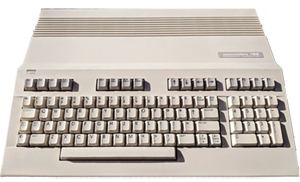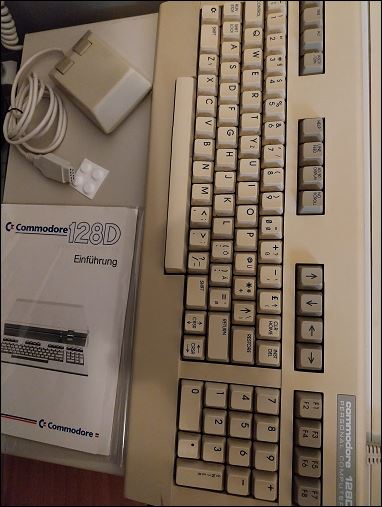"Equipped with Dual CPUs and Capable of Running Multiple Operating Systems" 
Produced between 1985 and 1989, the Commodore 128 was Commodore’s final 8-bit home computer. Featuring two processors—the MOS 8502 and the Zilog Z80—the C128 could run Commodore BASIC and GEOS using the 8502, and CP/M via the Z80. In addition to the standard model, two desktop variants (C128D and C128DCR) were released, featuring a built-in 5.25” 1571 floppy disk drive and a 93-key detachable QWERTY keyboard.
- Launch Price: C128: $299 (equivalent to ~$850 in 2024) and C128D: $499.95 (equivalent to ~$1,420)
- Estimated Total Units Sold: ~4 million units (~2.5 million standard C128 and ~1.5 million desktop models)
![]() C128 AT A GLANCE
C128 AT A GLANCE
Launched in July 1985 (UK) and November 1985 (North America), the C128 was engineered by Bil Herd, Dave Haynie, and Frank Palaia. All C128 models shared several core features:
- Fully compatible with the Commodore 64
- Dual CPUs:
- MOS 8502 at 2 MHz
- Zilog Z80 at 4 MHz
- 128 KB RAM (2 x 64 KB banks, expandable with REUs up to 512 KB)
- 72 KB ROM
- 16-color RGB palette, up to 640x200 resolution (non-interlaced)
- Runs Commodore BASIC 7.0
- Built-in CP/M 3.0 OS support (via Z80 CPU)
- Access to thousands of titles, though few were exclusive to the C128
 C128 Desktop Models: C128D & C128DCR
C128 Desktop Models: C128D & C128DCR

C128D (Primarily sold in Europe)
- Plastic case with carrying handle and keyboard dock
- Built-in cooling fan
- 16 KB VDC video RAM (8563 VDC chip)
- Built-in 5.25" 1571 floppy drive (360 KB, reads both GCR and MFM formats)
- 93-key detachable keyboard
- Fully compatible with both C64 and C128 software
C128DCR (Mainly sold in the U.S.)
- Metallic case, no cooling fan or keyboard dock
- Metal joystick ports; Torx screws instead of Phillips
- Updated 1986 ROMs with bug fixes
- 64 KB VDC video RAM (8568 VDC chip)
- Uses the MOS 8580 SID sound chip
- Built-in 1571 floppy drive (as above)
- Fully compatible with C64, C128, and C128D
 Operating System
Operating System

While the C128 does not support multitasking, it can operate in multiple modes:
- C128 Mode (BASIC 7.0): For running advanced BASIC applications
- C64 Mode: Offers near-total compatibility with C64 software
- CP/M Mode: Via the Z80 CPU for running CP/M 3.0 applications
- GEOS: Graphical OS with an enhanced version for the C128 -More about GEOS
Boot Process and CPU Role
At startup, the Z80 CPU briefly checks for a CP/M boot disk. If none is found, control shifts to the 8502 CPU, and the machine enters native mode.
Entering C64 Mode
The C128 can boot into C64 mode in three ways:
- Hold down the Commodore logo key during boot
- Type
GO 64at the prompt - Insert a C64 cartridge and reboot
Software Library
- Dozens of dedicated C128 applications (e.g., SuperScript 128, SuperBase 128)
- Thousands of CP/M programs: business, graphics, sound, and productivity
- GEOS software: Enhanced for C128 with mouse support
- Nearly 10,000 commercial C64 titles -Thousands of video games
- About 50 dedicated C128 video games
 Colors & Graphic Modes
Colors & Graphic Modes
 The C128 offers significant graphics improvements over the C64:
The C128 offers significant graphics improvements over the C64:
- Compatible with all the original C64 modes
- 16 RGB colors
- A dedicated graphics chip called Video Display Controller (VDC) provides 80-column color video output (CGA-compatible display)
- 16KB VDC video RAM for C128 and C128D
- 64 KB VDC video RAM for C128DCR
Video Modes:
- 320 x 200 (16-color palette)
- 640 X 200 (16-color palette)
- 640 x 400 (interlaced)
- 40 x 25 columns (Text mode 1)
- 80 x 25 columns (Text mode 2)
![]() Audio Capabilities
Audio Capabilities
Like the C64, the C128 features the legendary SID synthesizer chip:
- MOS 6581 SID or MOS 8580 SID (C128DCR)
- 3 channels with ADSR envelopes
- Waveforms: triangle, sawtooth, variable pulse, noise, and combinations
 I/O Ports
I/O Ports
All C128s:
- 2 Joystick/Mouse ports (compatible with classic 9-pin joysticks)
- CBM Serial port (Round female DIN)
- CBM Datasette port
- User port (parallel programmable)
- Monitor port
- RF Audio/Video port
- C64 expansion port
On Desktop Models:
- Keyboard port
 Expansions & Upgrades
Expansions & Upgrades
There are a lot of available upgrades for the C128:
VIDEO CABLES
- Commodore 128 RGBI 40/80 Columns 16 Color SCART Cable (Connecting C128 to any modern TV via SCART)
- C128 VGA Upscaler
- RCA S-Video Stereo Cable
STORAGE UPGRADES
- SD2IEC 1541 Disk Drive Emulator (SD Card Reader)
- Kung Fu Flash Cartridge (SD Card)
- Pi1541 1541 Floppy Disk Drive Emulator (real-time and cycle-exact) that runs on a Raspberry Pi (SD Card Reader)
- Sidekick64 (Kernal/SID/FM/Freezer/RAM)
- Fast-Loader Cartridge
- TeensyROM Cartridge for Commodore 64/128 offering MIDI, Fastload, Emulation, and Network
RAM UPGRADES
- C1750 512K RAM Expander
- Extender Card for memory expansion port
- NeoRAM Remix 2MB memory expansion for Commodore 64/128
- RAD Expansion for Commodore 64/128 -RAM expansion using a Pi Zero 2
MISCELLANEOUS UPGRADES/ADD-ONS
- C64/C128 StrikeLink WiFi modem
- 1351 MOUSE FOR COMMODORE 64/128 (For GEOS)
- Diagnostic Cartridge for Commodore C64/C128
 C128 Enhanced Software
C128 Enhanced Software
Table: C128 enhanced games and programs:
| A Mind Forever Voyaging | Graham Gooch’s Cricket 128 | Pentagram | Test Drive II |
| Air Cav 128 | Grand Prix Circuit | Personal Choise Collection | Tetris 128 |
| Alien Invaders | Gunfright | Planetfall (Solid Gold Re-release) | Thai Boxing 128 |
| Alleykat | Gunship | Pocket Planner 3 128 | The Thing |
| Arkandoid C128 | Hearts (80 Column Mode) | Prince of Persia | The Three Musketeers (Computer Novels) |
| Backgammon | Hitchhiker’s Guide to the Galaxy (Solid Gold Re-release) | Pro Coach: A Football Strategy Game | Thunderchopper |
| Beyond Zork | Invaders 128 | Project Stealth Fighter | Trader v2.2 |
| Bomberland | Kickstart 128 | Qix | Trinity |
| Bruce Lee II | King Size | Quest for Adventure | Ultima V |
| Bureaucracy | Klondike Jones | Rhapsody 128 | Up Periscope |
| Burgerwhop | Last v8 | Rocky Horror Picture Show 128 | Uridium Plus |
| Das Ding | Mah-Jong | Seeraeuber | Vectors |
| Dice Poker | Mega Apocalype | Sherlock Riddle of the Crown Jewels | Wheel & Deal 128 |
| Elite128 | Mikes Maze | Solitair 80 | Wizardry 1-5 |
| Federation Space 128 | Millifoot 80 | Space Battles 128 | Wumpus 2.0 |
| Ferrari Formula One | Morpheus | Space Pirates 128 | Yahtzee |
| Flight Simulator II (patched) | Morpheus C128 | Stealth Mission | Zork I (Gold Re-release) |
| Football 128 | Mr. Quizzer | Stratton | Zork the Undiscovered |
| Games 128 (Compilation) | Paperback Planner 128 | Super Bread Box | |
■ Commodore 128 Computers
Binaryvalue.com 2022 (c)
Sources:
- https://en.wikipedia.org/wiki/Commodore_128
- https://www.commodore.ca/commodore-products/commodore-128-the-most-versatile-8-bit-computer-ever-made
- https://armchairarcade.com/perspectives/2018/04/02/master-list-of-commodore-128-games-and-software






